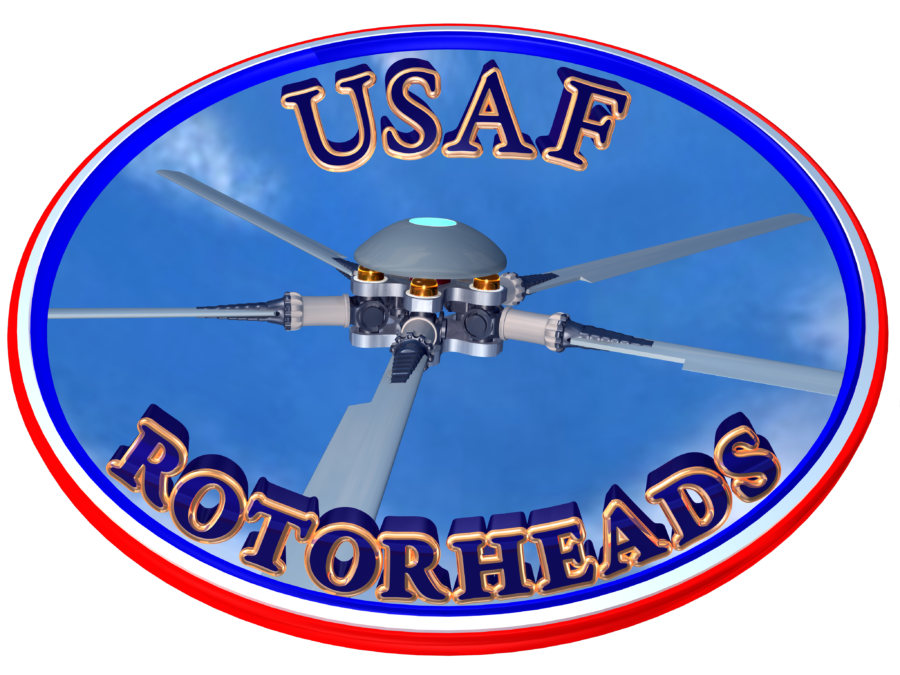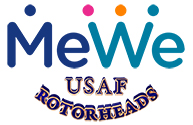USAF Rotorheads Stories
THIS STORY COURTESY OF BEVON DOWELL
CH-3B Open Ocean Rescue
Otis AFB, MA
09 April 1962

CH-3B
Our CH-3B open ocean rescue mission took place on a Friday afternoon. I had just finished a post-flight on an H-21 and was about to leave the hangar when I heard the phone ring. I figured it was an irate wife wanting to know when her husband would be home. The longer the phone rang the more urgent it seemed to me so I ran upstairs and answered it. The call came from Base Op's informing me we had a rescue mission some 150 miles out and to get the "B" model out and ready to go ASAP if not sooner. The flight crew and medic were on their way. Since I was by myself and no one to help with the towing action I took it upon myself to do it alone. The blades were folded which really helped getting the aircraft out of the hangar.
Just as I was driving the tug and tow bar back into the hangar the crew arrived in nearly full panic. Captain Winden told me there was a man on the Ursla M. Norton out of New Bedford that had a ruptured appendix and that we need to launch in a hurry. Number one engine was started and the blades were spread into flight position then number two was started. After all of the pre-taxi checks were completed we lifted out of the chocks and were boring a hole through the wind at 140+ knots.
As we got "feet wet" Op's informed us the little fishing boat did not have an operational radio but we could identify the vessel with the inverted American flag on the stern. Not the best news but better than none at all. The further out we flew the more small fishing boats we saw especially as we flew past one of the Texas Towers. Most of them were Soviet vessels around the mother ship. So now it was "guess where the little boat is".
After about 20 to 30 minutes we spotted the boat bobbing up and down in rather high waves flying the inverted flag. The patient was already on the lorry stand on the stern ready for pick-up. As we maneuvered over the boat the mast was a huge obstacle and eventually wound up between the sponson and fuselage. I was calling out directions the best I could with changing conditions. I had a handful of hoist cable as well as the *"joy stick" which was all but useless in the high winds so I let Capt. Winden take control of the aircraft.
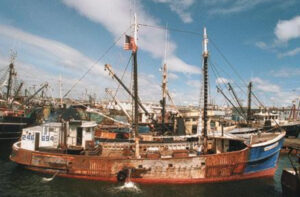
Ursala M Norton (Marrisa Ann)
I got the litter basket on the lorry stand just barely as the boat crew loaded the patient in and fortunately strapped him in really tight. They gave me a thumbs-up sign, I started to bring the basket up then bad luck struck. The basket got entangled in one of the wires to the mast but like the dedicated soul I was, I kept on reeling the basket up. Just as the basket got untangled the patient’s suitcase and hat flew out of the basket and into the drink.
The medic and I took a look at the patient and noticed a small red bump on his forehead which was not life-threatening. By now we were heading east back to Otis. The pilot informed Op's we had the survivor on board and was inbound to Home Base. As we flew over
Martha's Vineyard the forward fuel tank low-level light came on and I'm thinking we might have to swim home before this is all said and done.
About 30 miles out the aft tank low-level fuel light came on, by now there was a small bubble of fear right behind my belt buckle. We still had not seen dry land and at 150 knots we were bingo fuel as if there was no tomorrow. When we did finally touch down at Otis on a single engine, the remaining engine flamed out so the ambulance had to come to us on the active runway to retrieve the patient who was not is the best of shape by any means.
About two weeks later MSgt McDowell, the helicopter Section NCOIC was giving my name, home town, rank, and Wife's name to someone on the phone. I asked him who he was freely handing out my information to. He told me the man we rescued was claiming we had given him a bad case of Amnesia and was suing me and the crew for a million dollars! Talk about pucker time!!!! He let me stew and fume for an hour before he told me that was the base historical office wanting to know the details of the mission.
Unfortunately, I do not remember the co-pilot's name or the medics name but will do some research and if I locate the names I'll pass them on.
We did receive the Wing "S" award from Sikorsky in a ceremony in the Wing Commander's office complete with coffee and cake then back to work. Our certificates were signed by Igor himself as well as Mr. Lee President of Sikorsky Aircraft.
For years we held the record for a rescue mission, non in-flight refueling, some 300+ miles. I would imagine by now that record has been broken which is fine with me, let someone else have the fun.
Bevon
*"Joy Stick" - The "fun part" of the new aircraft (CH-3B) was the "joy stick" on the left side of the cargo door that would give the hoist operator 11% authority to maneuver the aircraft during a rescue mission.
THIS STORY COURTESY OF JOHN HATCH
CH-53C, 70-1625 Mission Landing Damage
Date: 24 March 2004
To: All THE CREWS that have flown or worked on these "TUFF OLD WAR BIRDS"
From: John L. Hatch, MSGT, FE, (Retired, 1982 and Still Kicking)
Subject: Helicopters CH 53C, 70-1625, and CH 53C, 70-1626, on or about 15 June 1972
(Aircraft 625)
I had been assigned to the 21st S.O.S. NKP Thailand, in April of 1972, after completing my in-country aircrew training, I was scheduled for my 1st combat mission and my "across the fence check ride". My first mission was part of a large flight tasked to airlift a very large contingent (1800-2000) of indigenous allied soldiers. We had picked up the soldiers, but in route to the drop off L.Z. the weather in the area became too bad to do the mission. We then returned with our soldiers to the pick-up point. This aborted mission was completely un-eventful and was re-scheduled for the next day.
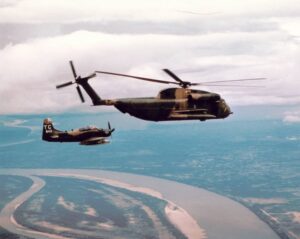 |
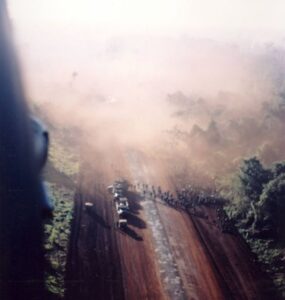 |
 |
|---|---|---|
|
CH-53C with A-1 fighter escort heading |
One of the reasons we were called "Dusty's" |
8 CH-53s and 2 Chinooks’ |
The next day we had our normal mission briefing at T.U.O.C. I remember the Squadron Commander "J.D. Koons" telling us at the end of the briefing that we had a very large L.Z., (about 2 football fields in size) and since we would be pretty heavy with 45 soldiers, (base load + 10, and -7, 3925 SHP Engines) we should make a rolling touchdown landing. We picked up our soldiers again and flew to the drop off L.Z. Lead, 2 and 3 had rolled them on, and off-loaded their soldiers and equipment that had already made contact with the bad guys half a click away.
I was in the 4th Helicopter of the flight. I was at the door giving approach instructions, as we touched down and rolled approx. 75 feet, ALL HELL BROKE LOOSE. All of a sudden I found myself buried among toppled soldiers and all their gear. I thought to myself, in that instant, WHAT THE HELL HAVE I DONE!!!!! While I was trying to dig myself out I thought I heard someone on the radios broadcast, “FIRE!!!, FIRE!!!.” This really intensified my actions as well as those in the cockpit who were busy chopping the throttles and doing whatever else they needed to do to egress the cockpit.
Now that we had all gotten out to safety it was time to see what had happened. After checking that everyone was OK, except for minor scrapes and cuts, we still had the mission in progress all around us. We were shutdown in the very middle of the L.Z. Everyone else had to plan their approaches to a hover, either in front of, or behind us. There was also another helicopter damaged behind us. We were trying frantically to assess the damage to the aircraft while the firefight was raging half a click away. We all surmised that the right main landing gear had sunk into a soft spot in the ground clear up to the bottom of the sponson as we rolled over it, we left a furrow in the dirt about 40-50 feet long from the main gear and strut ripping/plowing thru the earth. The most amazing thing was that just as we came to a stop, the wheels rolled back up on level ground again, with only one flat.
We had also surmised that as a result of this ripping/plowing action that was dragging us to a stop and the fact that everyone was thrown forward that the pilots hand must have also been thrown forward while on the cyclic stick causing the rotor blades to be directed downward, slicing through the top of the helicopter. The blades tore off the forward cowling, heater, co-pilots green window, #1 EAPS, and the doghouse sliding cover (just to name a few). The smoke and dust caused by the disintegrating fiberglass fairings must have looked like FIRE or SMOKE, hence the "FIRE" transmission from another Knife helicopter. The FE’s and Pilot's contemplated all the damage. The blade pockets were damaged badly about 4-5 feet from the cuff, the BIM indicators were still WHITE, to everyone’s amazement. WE, as a CREW, decided that we could and should try to fly the ol'e gal out to a safer area to clear the L.Z. for the mission. We were ripping off everything that we could and tying everything else down by running several cargo tie down straps through the door and window and over the top everything to tie it down for flight, with a fire fight raging not too far from us, we were in somewhat of a hurry, because we were sky lighting (an easy target) on top of the helicopter securing everything.
We climbed back in after WE ALL agreed that she was safe to fly????, went thru the checklist carefully, the Stan-Eval FE took the seat and was starting the APP. Errrrrrrrrr-OooooooH (WE ALL KNOW THAT SOUND). The APP did not start, the FE double checked the APP circuit breaker switch and the circuit breakers ran the checklist again, as we pumped up the APP accumulator to 4000 PSI, we knew that it was going to start this time. Errrrrrrrrr-OooooooH, Damn!! Another no start!!!! We pumped up the APP accumulator again, and again, checked the APP wiring, and everything else that we could think of, still it would NOT START. I‘ll bet that we pumped up that accumulator 15-20 times that day with no positive results, other than good exercise.
The decision was made to leave her in the L.Z. as she sat. We grabbed our war bags and equipment and returned to NKP on another Knife helicopter at the end of the day. The Question was asked, “Do you want her destroyed in the L.Z. with NAPALM?” The Squadron Commander said “NO”, that she had not been retro-fitted with the then highly classified brand new system “RHAW,” she was one of the few that hadn’t been modified yet and was a valuable piece of equipment he needed. She only cost $2.4 Million to build back in1970. The soldiers we had in-filled during the mission provided a security team to protect her overnight.
 |
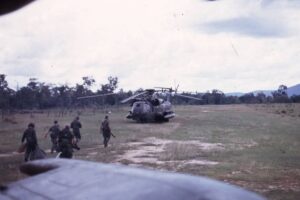 |
 |
 |
|---|---|---|---|
| Bill Scravantii the Flight Examiner giving me my Check Ride - June 1972 |
1625 Where we had left her in the LZ. |
Co-Pilots side striped |
Pilots side striped out to reduce weight for the lift |
After the first night we returned with maintenance personnel and equipment to try and get her started again. They had Engine, APG, Electrician and Hydraulic Mechanics and a new APP in the box. They worked all day trying to get her to start, even changing out the APP. She just wouldn’t start again. While the maintenance people worked OUT IN THE MIDDLE OF LAOS, the rest of the crew and I waited, helping if and when we could, to fly her out. We had two helicopters setting in the L.Z. all day with the rotors turning and the engines at flight idle so that everyone could get out of there ASAP if need be. There was a lot of enemy soldiers still around, and there was 122mm enemy field artillery in the area that could reach the L.Z.
 |
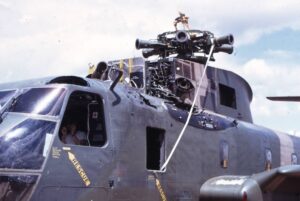 |
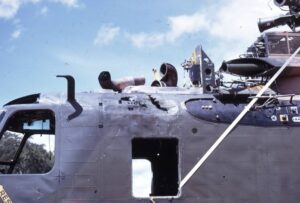 |
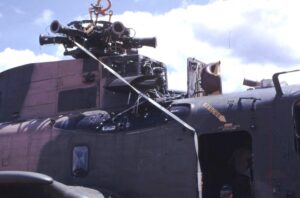 |
|---|---|---|---|
|
MX heading over to do the Striping |
Frag Grenade Damage - Stripped for the Lift - June 1972 |
Frag Damage - June 1972 |
Right side after Stripping - June 1972 |
We found out that the security team soldiers had been chased off during the 2nd night, the enemy soldiers had fraged her in the night with a grenade at the #1 nose gear box to fuselage area and shrapnel damage around the ramp, fuselage sides and the interior. After we found out that she had been fraged the Squadron Commander still wanted to recover His helicopter. A mission was set up for the recovery; she was to be completely stripped and recovered from the L.Z., in the middle of LAOS. We slung a flight line tubular crane to the L.Z., carried all slings, engine trailer, lifting adapters and tools to strip her. The maintenance people removed the fuel, fuel tanks, engines, rotor blades, tail rotor, engine drive shafting, pilot seats, and cargo roller tracks in the floor, all instruments, avionics gear, ramp, doors, and anything else they could remove fairly easily. This took about a week, every day 2 helicopters sat in the L.Z. with rotors turning, while the maintenance people did what they do best, we returned to NKP with a loads of parts that were removed that day, (this was long before the C-5 drills). All the maintenance people received the Bronze Star for their tireless efforts.
 |
 |
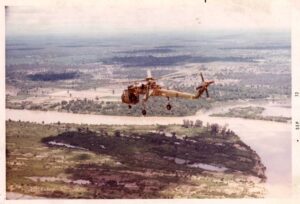 |
|---|---|---|
|
1625 Stripped and ready for the lift |
Sky Crane taking off for 1625 LZ for pickup - June 1972 |
Sky Crane heading for the lift - June 1972 |
 |
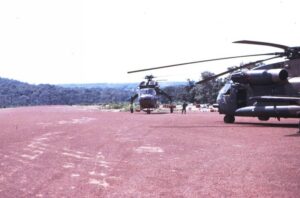 |
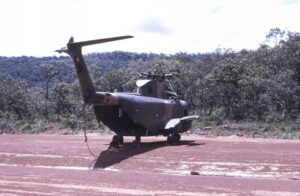 |
| Sky Crane ready to lift 1625 out | Sky Crane at Lima Site w/ CH-53C escort - June 1972 |
Safe at a Lima Site-Finally - June 1972 |
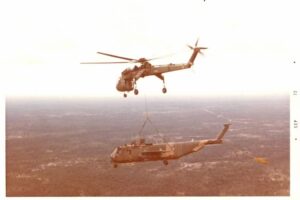 |
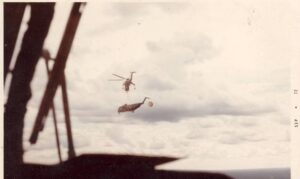 |
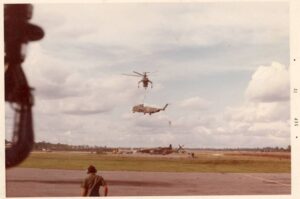 |
| Sky Crane with 625 - June 1972 | 1625 ON the Hook and on its way to Ubon AB - June 19721 |
1625 Arriving at Ubon RTAB - June 1972 |
Now that we had her lightened up, we had to get her home; we tasked an Army Sky Crane to do the lift. They rigged her up and attached their winch-cargo hook, and up they went, but not too easily, she was still too heavy and they over torqued their transmission lifting her out, but she was airborne again. When I landed in the L.Z. she weighed about 40,000 pounds, when she was air lifted out she weighed about 16,000 pounds. The rotor head and transmission were removed later at safer Air America Site. The Sky Crane was carrying minimum fuel and could only fly about 1.5 hours before needing fuel. In order to refuel the Sky Crane it would have to fly to an Air America Site landing strip, set down 625, and land, the escort helicopter would land, roll fuel barrels and pump needed fuel into the Sky Crane (In those days us Knives/Dusty’s refueled from 55 gallon drums of fuel and a gasoline powered engine driven 100 GPM pump).
 |
 |
|---|---|
| Refueling pump used to pump fuel from barrels |
Refueling hose in drop tank at FOL |
We normally carried the fuel pump aboard our helicopters, and used it to refuel the Sky Crane from fuel cashes at these landing strips. We delivered her to Ubon Airbase in Thailand for repairs, (The Army Sky Crane crew said that they almost pickled her couple of times because of oscillations) it took 6 months for the RAM team and maintenance people to do all the needed repairs to get her flyable again. ALL the FE's drew straws to see who was going to be the lucky one to fly the first FCF.
(Aircraft 626)
I mentioned earlier that another helicopter behind us was also damaged; it turned out to be 626. Their nose gear had apparently sunk into that same soft spot in the ground while they were rolling over it, collapsing the nose gear; it was setting on its nose in the L.Z. behind us.
After off loading their soldiers and looking at the damage the pilot and crew decided that the aircraft was flyable, they picked up into a hover, the pilot said that everything felt “OK”. The Lead Aircraft Commander told them to RTB to NKP Thailand for their needed repairs, they and an escort helicopter took off for NKP. About 2 hours into their return trip to NKP, the pilot of 626 was having flight control problems, he executed a right hand “EMERGENCY DECENT”, being followed by the escort helicopter, the pilot and crew picked out a sparsely wooded clearing, managing to hit the only tree in the L.Z. with the rotor blades during their “EMERGENCY LANDING” (as if being picky about a landing site was even an option for them at this time).
 |
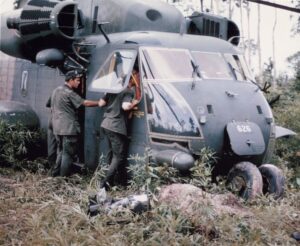 |
|---|---|
|
CH-53C 1626 after "Emergency Landing" |
CH-53C 1626 after "Emergency Landing" 1972 |
The nose gear was swinging in the breeze due to the broken components damaged earlier in the L.Z., as the pilot and crew made their “EMERGENCY LANDING” the nose gear was flung forward as the pilot made his flair, and as the nose of the helicopter settled onto the ground, the nose gear and wheels that were flung forward were landed upon. The crew chopped the throttles and shut down the helicopter ASAP! (Any landing you can walk away from is a good one, TWO IN ONE DAY, WOW!). In all their excitement the Stan-Eval FE in the jump seat forgot to close the EAPS, DAMN!!! The crew loaded into their escort helicopter and was taken back to NKP.
The next day the maintenance people loaded up 6 new rotor blades and their equipment and were flown out to the Emergency Landing site to make the needed repairs to the helicopter so that it could be flown back to NKP. In their inspection of the extensive damage to the helicopter the maintenance crew discovered and deduced that the hydraulic actuator for the nose gear had buckled upward when it collapsed and into the nose wheel well inner sheet metal structure, hitting and cracking the under floor cyclic stick interconnecting nested control tubes (2 each), thus allowing the control tubes to break completely in half “IN FLIGHT” and giving the pilots very little if any cyclic control (This incident might be a very good future FLIGHT SAFETY topic). I don’t know if the pilot or anyone else will ever really know how he put that helicopter on the ground SAFELY, but they all walked away without any injuries. I think at the time of the landing all the pilot had was "Cyclic Trim"!!!
“THEY WERE DAMN LUCKY”
A little about the Pilot:
He was an older Lt. Col. who had kind of lost his touch at the controls, a lot of the guys didn’t like flying with him because of this. There was a period of time when I was first assigned to the unit that we were not getting very many heavy gross weight combat missions, to help keep up our heavy gross weight proficiency it was decided that we would load up a 3500 pound MD-3 flight line generator/power unit internally to simulate soldiers and equipment weight and practice our heavy gross weight operations. One particular day I was his FM/FE in the jump seat, we were doing 360 Degree Auto Rotations (They used to scare the hell out of me, being new at this game). On one practice autorotation approach he fell through on his flair at the bottom and we touched down, and then bounced back into the air during the power recovery phase. The Instructor Pilot decided that we had enough of that for the day and we did something else. After what he did with 626, I would have flown with him any time, and did so on many occasions. When it came down to when it really, really counted “HE HAD HIS S--- TOGETHER”.
In closing I would like to say that these 2 helicopters in particular, and all the others H-53’s in general have fought and flown hard to get where they are today. Please take care of them, they all have their scars and have survived countless battles. They deserve everyone’s respect. I do sincerely hope that this letter and accompanying photographs will find their way into the aircraft and squadron historical folders for all to enjoy. Please show this care package to the maintenance folks, without their tireless efforts we probably wouldn’t have these Ladies that we all enjoy flying today. I know that the maintenance folks feel un-appreciated sometimes, but I for one am “DAMN PROUD OF THEM" for being able to keep all these Ladies in the air for the past 38 YEARS. I am also “DAMN PROUD” of all the AIR CREWS who have flown these Ladies the past 38 years and brought themselves and countless others home to safety. I know that it has not been an easy task for you, and all those who have gone before you, with all the WARS, assignment changes, personnel and equipment taskings, and the many aircraft modifications that have transpired throughout these past decades.
KEEP UP THE GREAT WORK “ALL OF YOU” ARE DOING!!! ESPECIALLY THROUGHOUT ALL THESE DANGEROUS AND TRYING TIMES OUR NATION AND YOU ALL ARE FACING RIGHT NOW.
Gods Speed to you ALL, and may you ALWAYS return home to your loved ones safely.
Sincerely,
John L. Hatch
MSgt. Retired 1982
THIS STORY COURTESY OF JOHN HATCH
2 - CH-53’s Rotors Turning, Blade to Blade Contact in LAOS
This all happened in June of 1972, about 2-3 days after the 625/626 mission; and this narrative is 40 years after the fact, and from “OLD” Memories, I will try and be as accurate as I can be.
Anyone else who has memories of this are welcome to contribute to it accuracy, and their story too.
626 had made an EMERGENCY LANDING with only VERY LIMITED CYCLC CONRTOL.
The maintenance people went out to the landing area for inspection and repair of the aircraft, they changed 6 rotor blades by hand, replaced the Cyclic Sticks inner- connected Nested Torque Tubes with the nose of the aircraft lying on top of the nose gear and the belly on the ground. Don’t know how they got under it for the repairs if needed, other than to dig a hole under the aircraft, don’t know if they had to or not, I can easily surmise that it was not EASY fixing 626 for a one time flight back to NKP for proper repairs.

CH-53C 930 Shut Down After
Blade to Blade Contact
June 1972
The story continues:
We had been tasked to airlift a large contingent of allied indigenous solders into a ground operation.
We showed up I think with 6 CH-53’s at an Air America Lima Site in LAOS for briefings and to start the airlift. After everyone was rotors turning and ready for taxi, lead started to taxi out onto the air strip, as he taxied out and was turning left to take the runway for take off, (his scanner failed to clear him for this left turn) his Rotor Blades struck #2’s Rotor Blades and parts went FLYING everywhere, Luckily no one was injured from the flying debris from the rotors blade to blade contact between the 2 aircraft.
Just happened to be the Squadron Commander at the controls of the lead Aircraft, what can you say, stuff happens, in private it was probably very intense to say the least.
“Everyone Shut Down” Now what do we do??????
Upon inspection it was learned that we damaged 7 Rotor Blades and they had to be replaced.
Lead sent 2 aircraft back to NKP for rotor blades, when they got there; supply/maintenance only had 1 in stock. They loaded up that 1 blade and some maintenance personnel and took off for the 626 landing/crash site. The maintenance guys removed the 6 rotor blades by hand they has just installed by hand on 626 and loaded them onto the helicopters for the flight to the Lima Site. (Each blade weighs approx. 400 Pounds). The blade pockets are very delicate and can be damaged very easily if not protected from damage, this task was probably very hard to do, I think they use some old GI mattresses that were common in the H-53 units incase of landing gear failures or malfunctions. But, that is another story in its self, maybe a maintenance guy can relate to the experience and let us know how much fun it is, is not!
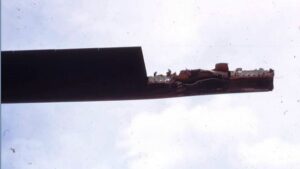
CH-53C 930 Blade Tip Damager
After Blade To Blade Contact
June 1972
The aircrews and maintenance personnel manhandled 7 rotor blades down, and manhandled 7 rotor blades back up onto the 2 aircraft from the ground, the maintenance guys Torqued and Safetied everything and adjusted for the Pre Tracking differences on the different blades (Thank Goodness for the forethought of the Sikorsky engineers for providing this procedure, otherwise we would have been tracking the rotor blades too)
After getting the Helicopters repaired we proceeded with the mission, it was a very long day as I recall, I am sure we refueled too, we did it from 55 gallon fuel drums in those days, provided by Air America. We pumped the fuel into the aircraft using a gasoline engine driven 100 gallon per minute pump, and usually rolled 18-20 barrels of fuel up to the aircraft, stood them up (450 pounds each) popped the top and pumped them into the aircraft fuel tanks. We usually tried to use 2 guys’ to stand them up, but that didn’t always happen. I can remember many times that I, being a young buck back then, would stand them up all by myself. I had the pleasure and honor of receiving a hernia for my efforts, but did not tell anyone because I wanted to fly “Combat Missions” and a hernia would have grounded me.
So, all in all the mission was done, we got some very good and valuable experience on what “NOT TO DO” We gained some respect for the maintenance folks and now have some idea of all the things they have to do to provide us OPS Folks with and aircraft we need to do our job, with the OLE H-53.
We totaled approx $250,000 in Rotor Blades that month between 626 and this mission, has to be some kind of RECORD, although not a very good one, especially for the TAXPAYERS.
Hope all enjoyed this; it is accurate to best of my memory I swear, although my memory is getting aged these days, like most of us OLD ROTORHEADS.
We were just going Gangbusters when I first got over and into the 21st SOS Knifes/Dusty’s. I sure am happy that things settled down after the Blade-to-Blade incident, I don’t know if I could have taken a year of things like this.
John L. Hatch
MSgt. Retired 1982
THIS STORY COURTESY OF JOHN HATCH
Hurlburt Field and many other places...
My recollections from “32” years ago, and much after the Fact.
I had been re-assigned to the 41st ARRS at McClellan AFB, California in May of 1980. In June of 1980 the HH-53’s of the unit were tasked to deploy to Hurlburt Field in FL. for “Operation Honeybadger” the C-130’s of the unit were tasked to provide in-flight refueling, but were not to part of the operation.
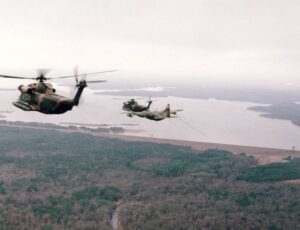
1980-1982 Typical trip with Refueling
Operation to Hurlburt Field FL
and back to McCellan AFB, CA
or Vise Versa.
All the H-53 of active units supplied the aircraft including the highly modified Pave Low aircraft; I think we had 12 H-53’s land at Hurlburt for the operation with the 1st Special Operations Wing and the 20th Special Operations Squadron.
After we all arrived the UH-1N and CH-3 folks and aircraft were GROUNDED! They were told to support us H-53 folks in any and every way, witch really ticked off the guys of the 20th, but they obeyed the order. We started flying NIGHT training missions shortly thereafter, first we needed training on the use of Night Vision Goggles (NVG’s) We were tasked to perform many types of night missions from mild at first to Wild as we became more accustomed to the use of the NVG’s.
We had different aircraft Call Signs at first, but someone came up with the idea that, since we all came into Hurlburt like a bunch of “COWBOYS” and took over the place maybe we should use the call sign “Cowboy” everyone liked it, and it stuck, the 20th H-53’s used the Cowboy call sign from then until the unit was deactivated in October of 08 and the H-53’s were RETIRED after 42 years of life long service to the US Air Force. Most were lucky enough to reach retirement, however a lot of them did not, mostly due to the HIGH TREAT environment they operated in from their first takings with the Air Force, South East Asia, NASA, Space Capsule/Drone Recovery, Special Operations, Etc., Etc. Most of us considered and accepted these risks in the performance of our duties flying with the H-53 as just another day at the OFFICE, as it became the norm for us.
Did you ever hear the joke about 2 Pilots that landed sideways on the runway? One Pilot says to the other, “dam this is a short runway”, the other Pilot replied, “yes, but it sure is “WIDE”.
This kind of explains some of the limitations we placed on ourselves in doing our training. We would deliberately limit our point of landing for the precision of the maneuver. Sometimes everything worked out ok, sometimes it didn’t, and we would damage the aircraft in some way occasionally. It was like practice bleeding, at some point you determine that this is not healthy and change your procedure to a safer one.
You might say that “We Were Writing the Book on H-53 Night Special Ops” They told us on many occasions in the mission briefings to be “CAREFUL” out there, since there was no “OFFICIAL” written guidance or regulations for us to use as guidance in our operations.
I was flying on HH-53’s and not on the Pave Lows, we were using the Gen II, NVG’s, in our training an operations and one big problem for the Pilots was referring their instrument scanning to another person such as the FE, they wanted to be in control of the aircraft. So we modified $6500.00 a pair NVG’s by cutting out the bottom of the housings so that the Pilots could have the look down capability to scan their instruments, at least somewhat, we had the cockpit lighting OFF, or at least subdued by using, should I say it, “DUCT TAPE” any glare was terrible for the NVG’s and reflected off the windshield making it hard to see with the NVG’s. We and the Depot folks were working on lighting that would be out of the light spectrum that was viable to the NVG’, it took a long time to get if figured out and working satisfactorily. Because extraneous light was such a problem in the cockpit, I devised and fabricated a light for my finger; can you say E.T.? I took a small light bulb like the 327 bulbs used for instrument lighting, put it into a housing, connected a 9 volt battery as a power supply and Velcro’ed it to a strap and strapped it to my arm, made a small reed switch and put it between my thumb and fore finger of my Flight Glove, Then took a small Fiber Optic Cable end and sewed it to my Flight Glove for my right hand index finger. It worked fantastically, all I had to do was press the reed switch together and I got a subdued small 1 ½ inch circle of light to read the check list, etc.
We “SLICKS” as they called us guys with the HH-53’s did everything the Pave Low guy’s did, only WE did it with the Mk-I eye ball and the NVG’s. Of course we were severely lacking in the “O” visibility category. One time, on one of our many night training flights the Pilot flew straight into a Rain Storm while on NVG’s, he went BLIND, as in he could not see anything, he started calling for LIGHTS, LIGHTS, meaning he wanted the cockpit lights turned on so he could see his flight instruments as he was wanting to transition back to Instrument Flight Rules. I was his FE and was fumbling trying to find the light switches since I was also on NVG’s. While I was finding the light switches he was yanking off his helmet and NVG’s to be able to see the instruments, I think we were about 200 feet above the ground when this happened. This happened before we got the idea to modify the Pilots NVG’s. After this hair raising Religious experience, I got out my trusty roll or do I say it again, “DUCT TAPE” We always carried a roll for subduing any and all lighting that was a problem for the NVG’s. I took some tape and put it around the lighting switches and rheostats that were very important. Since it was always so hard to find things when wearing NVG’s, all you had to do was wave your hand along the lighting panel and boom, there was the switch you needed, the tape is still on the H-53’s today for the very same reason. The FE’s usually kept one di-opter of the NVG’s focused to the outside of the aircraft and the other one focused for inside the Cockpit, all you had to do was open or close an eye to see what distance you wanted to see, they were adjustable, but things were always fuzzy to me when looking at things inside the cockpit.
We were getting pretty well accustomed to the NVG’s after awhile, we would fly on ANY night regardless of the available light that night. On a NO MOON night it was really, really dark out there, we flew closer to the ground and a little slower on these nights. Ever heard the saying “you couldn’t see your hand in front of your face?” We were out there flying in that darkness, lights OUT, only the rear beacon on top of the Tail Rotor Pylon and the Rotor Blade tip lights were on, so that the other aircraft could see us with their NVG’s. We flew so many nights like this, on full moon nights we repeated the Police Academy saying, Goggles, we don’t need no stinking goggles, it was so bright compared to no moon nights, it almost looked like broad daylight to us.
One of or training mission taskings was a maneuver they wanted us to practice and do, they laid out a 200 meter taped square in a very large area for us, the object was to do a “6” Ship simultaneous touchdown landing within the taped boundaries, We said YOUR CRAZY! The H-53 is 85 feet long and has a 72 foot main rotor, we felt that this was a risky operation to say the least, they said, “WE HAVE TO DO THIS” so we went out and practiced and practiced this over and over, we finally got proficient at it and it became comfortable for everyone to do. Then they told us that they wanted us to do it using NVG’s we told them then that they were “REALY CRAZY”. Again they said “WE HAVE TO DO THIS” so we went out and practiced and practiced this over and over, and again we finally got proficient at it and it became comfortable for everyone to do. I Can’t say that it didn’t get very religious at times, but when we were finally able to do this maneuver it kind of water our own eyes, as it was very impressive to see 6 big helicopters make a simultaneous landing with no lights at night.
Some of you are probably wondering how we were able to do some of these things; it wasn’t easy to say the least. Our Chain of Command was “VERY SHORT” it went form Sq. Commander to Wing Commander to the Joint Chiefs, I think headquarters were bypassed, (although I’m not sure on that, they were trying to keep information secure) because this was a High Priority Special Ops Tasking. We did have a lot of help though, the Depot Teams worked hard and Fast Too, they were doing upgrades the whole summer of 1980 and beyond. Some of the things they did first was they installed a Pilot controlled Infer Red (IR) search light so that he could see with the NVG’s, they removed the Old and antique DOPPLER navigation system originally installed in the aircraft for the Navy Contract in 1966, and installed a Palletized Inertial Navigation System (INS) so that we could meet our Time On Target (TOT) requirements that any Special Operation mission required.
Because of the equipment failures incurred in “Desert 1” (Failed Rescue Mission into IRAN to get the Embassy Hostages in 1980)
The Joint Chiefs asked us what we needed to make the aircraft more viable for the Special Operations Mission, we gave them a list of desired improvement we needed.
The basic list is below:
Higher Horsepower Engines
Horse Power is the Life Blood for Helicopters. Ours had 3925 HP engines; there were 4300 HP engines available in the supply system. Depot Guys acquired and started installing the new engines.
Weapons for better reliability and Stand Off range
Depot Guys acquired and started installing the new .50 caliber weapons, and fabrication of new gun pintle mounts for all 3 gun positions.
When we acquired the .50 Cals they were wrapped in Cosmoline, the Old Heads know about this stuff, when the weapons were cleaned up, the date on the weapons was 1941, brand new with not a speck of rust to be found.
After the fabrication of the new pintle mounts for the .50 Cals, we started to use them in training.
Problem: When you fired one .50 Cal the instrument needles would shake, when you fire both .50 Cals the instruments would vibrate/shake violently.
Solution: Depot guys found hydraulically dampened Soft Mounts for the .50 Cals. Brand new off B-17’s from WW II, then you could fire both .50 Cals with just slight needle movement.
Counter Measures for Heat Seeking and Radar Guided Missiles
Depot Guys acquired and started installing Flair and Chaff dispensing systems onto the aircraft. They went to the A-10 Assembly line and took the systems off the aircraft being built.
Secure Radios for OPEC
Depot Guys acquired and started installing Secure Voice UHF/VHF Radios, not sure about the FM radios though.
Problem: Found out that Muammar Gaddafi bought the company that made the VHH Secure Voice Radios, OOP’s
Satellite Communication Provisions
So that you can talk directly to “THE MAN” for guidance if needed. Depot Guys acquired and started installing Secure Voice Satellite Communication Systems.
New Style Rotor Heads
Our rotorheads were oil filled and were always leaking; on LONG FLIGHTS this could be a big problem.
Solution: Acquire and install the new Elastomeric rotorhead, no lubrication required as components are mounted it RUBBER.
Problem: Sikorsky said that they would cost 1.5 Mil. Each and would be at least 2 years out. I guess they were put on the future list; all the 20th and 21st unit aircraft have the Navy/Marine style folding self Tricing Rotorheads on them when they retired I think, don’t know if it is the Elastomeric head or not.
Crash Worthy Aux Fuel Tanks
WE needed RANGE, so they installed the 650 gallon Aircraft Ferrying aux tanks.
Problem: The 650’s did not have explosive suppressing foam installed
Solution: The Depot Guy’s “HAND CUT” and installed the foam in the 650 Gallon Tanks.
Problem: The 650’s were still not CRASH WORTHY
Solution: The Depot and Vendor Engineers got together and fabricated a new style 600 gallon Aux Tank. The tank was made by wrapping several layers of Kevlar to make a tank, don’t know what they used as a form, or if it has foam or not, I think they were made without the foam inside. After fabricating the test prototype tank they filled it with water and dropped it from 30 feet, no leaks, it passed the requirements and was manufactured and installed on all the H-53’s, as they were made available, still there today too.
We spent one HELL of ALLOT of money in 1980, but we gained a capability that we never had and needed badly to cope with this CRAZY WORLD we live in today.
My hat’s OFF to all the brave souls that continued what we OLD TIMERS started, they have been ALL OVER THE WORLD with this Capability, risking their lives on a daily basis and have brought countless soles home to safety. WELL DONE!!! Just another day at the Office, but your Office is a PAVE LOW, the most Suffistaked Helicopter in the World, PERIOD!!! I for one was very saddened to hear of it Retirement, the Word will miss it.
Anyhow back to Training
We were tasked to do Com OUT, Night In-Flight Aerial Refueling training, again we thought they were crazy, but learned earlier that they meant it. It was a little touchy at first, but then we settled into it ok I guess.
Then they upped the Anny, they wanted us to do it LIGHTS/COM OUT and with NVG’s,
We knew they were crazy then, after scaring the HELL out of ourselves a couple of times we finally were able to do it with some degree of confidence, although not a lot at first.
About NVG’s.
If you have never used them they take allot of patience to get used to, you have to find other references to rely upon when working with them. Take two toilet paper inner rolls and put them up to your eyes, that kind of simulates NVG’s although crudely. You will notice that you have almost “0” Zero Peripheral Vision, and severely diminished Depth Perception, now add Darkness and Dust to that. You discover that you use Shadows allot in judging height and movement around you. Now Go Fly in the Dark young man.
We flew all over the southern states, mostly in desert sites, and operated from clearings in the desert floor most of the time it was a very dust and dirty operation, when one would take a shower the water would turn BROWN from all the dirt from the training.
We worked and trained with Navy Seals, Marines, Army Green Berets, Army Rangers, Delta Force and others as well.
On one tasking from McClellan was that we were to go to Fort Lewis in Washington to do Special Ops training with the Army Rangers there. We were supposed to go to Ft Lewis fully loaded with weapons and ammo to simulate a real mission, so that the rangers would know what to expect with us. As we got up to Ft. Lewis we had pre planned that we would land at Ft. Lewis and they would put some Army Rangers on/around the Aircraft to guard the weapons and aircraft for us. As we got ready to go into Ft. Lewis the Air Force Control Tower personnel told us that we could not land at Ft. Lewis, we were US Air Force Aircraft and HAD to land at Mc Chord AFB, so we did.
Problem: We had Mini Guns and Lots of Ammo onboard to deal with.
Solution: Download all the Ammo and Mini Guns, Cary them to the Security Police Armory and turn them in to them, imagine this, a bunch of guys come in you door with so much ammunition wrapped all over them they looked like Poncho Via, plus caring Mini Guns in their Arms.
We also turned in our service revolvers that have plastic bullets and Hollow Points in them, one of the young Security Policemen in the armory asked what the red bullet were for. One of the guys said that we were in AIR RESCUE and that they were little transmitters that we would shoot into our leg so that the satellites could track us if we were shot down or captured because we all were on WORLD WIDE MOBILITY; he thought that was way COOL.
The nest day when we picked up all the Weapons and Ammo, the same guy was there, as he gave back the plastic bullets, He said to the guy who told him the story “Here’s you F’ing Plastic Bullets” He probably took a lot or ribbing on that one.
We loaded up and flew over to Ft. Lewis with no more problems from the Air Force, I guess someone talked to someone and it was approved for us to stay at Ft. Lewis, which was JUST across the runway from Mc Chord AFB.
I know that this has gotten pretty long to say the least, I did not cover “ALL ASPECTS” of the operation, but I did try and give you some insight as to what it’s like to fly around in the dark, and do your JOB.
What We Didn’t Know at the time we started this training was just What we were training for, lots of guessing, but no one knew for sure.
In case you have not figured what we were doing; we were training for a 2nd Rescue attempt to get the Embassy Hostages of Iran. Luckily, the hostages were released very quickly after President Ragan took Office in 1980. It could have been really nasty, but we will never know.
In Closing, I would like to say that even though we did not do the mission, we DID make enormous strides in building a capability that has gotten a lot better over all these years.
The 20th SOS, and the 21st SOS deserves enormous credit for developing these Special Operations capabilities.
If anyone knew Col. Bill Tackas, you knew how gruff of a guy he was, he would tell full Coronals to go to hell if he was right; he was my old Commander in the 701st TASS at Bergstrom AFB, Texas and became the Commander of the 20th SOS during Operation Honeybadger. I remember on one deployment to Panama, in a Mass Mission Briefing we were told that if we got shot down on the mission or had to make an emergency landing, that we would have to fend for ourselves. When He got up to brief us he said in no uncertain terms, “If anyone leaves any of my people on the ground, they will have ME to answer to when they get back”, and he meant every damn word of it too. He was an Old BROWN SHOE Coronal and had over 7’000 hours in the air mostly on HELICOPTERS!
I was very saddened to hear of his passing, with ALS of all things. He was a very proud Man and took care of his people with a gusto you rarely see today.
For those or you that would like to know more about this mission, it’s on line. Look for “Operation Honeybadger” we weren’t sitting on our hands in 1980
Also check “Operation Credible Sport” the C-130 side of the equation, would you believe A Rocket Powered C-130?
John Hatch, MSgt. USAF Retired
THIS STORY COURTESY OF JOHN HATCH
My Claim to Fame, The only FE to Put a 26 foot Boston Whaler inside a HH-53
During “Operation Honeybadger” and beyond training, circa, 1980, this question was asked by the Navy Seals.
Could we carry a 26 foot Boston Whaler inside the H-53 Helicopter?
We were tasked to test this out with a ground test on the ramp at the 20th SOS at Hurlburt Field.
Since I was an OLD, yet not too old member of the 21st SOS at NKP Thailand in 1972-73, we had received training and used the winches of the CH-53’s (Tactical Operations Configuration) in our unit occasionally. We requested that both of the winches and approach ramps for the ramp be installed on one of our HH-53’s (Rescue Operations Configuration) since the HH’s were designated as “SLICKS” I.E. the Heavy Haulers, and because our HH-53 aircraft did not have the Pave Low, Avionics Equipment Rack in the cabin, and we were also lighter than the Pave Low Aircraft.
They positioned the Boston Whaler on a pallet on the ramp behind the HH-53, we fired up the APP for electrical and hydraulic power, pulled out the winch cables and hooked them up to the pallet, turned over the rollers and tracks in the floor and ramp of the helicopter, adjusted the approach ramps on the ramp to allow the pallet to side up and onto the ramp roller tracks, and then onto the floor roller tracks of the aircraft.
I got out the winch control pendent and cable and started winching in the Boston Whaler, we had pre-measured the Boat and the inside of the helicopter and realized that it would be a TIGHT Fit, so we stripped everything off the inside of the helicopter for additional clearance and folded up the troop seats that were sometimes installed, to get them out of the way too.
While the pallet and boat were being winched inside, the winches could be controlled separately or together, so as it was sliding in, I could alternate from one winch to the other to jockey/guide the pallet and boat from side to side as the occasion arose to shift its path for clearance as it made its way inside the helicopter. IT FIT, with about 1-1/2 inches clearance on each side, I closed the Ramp and Door without any problem, in the front of the boat it was a tight squeeze to get into the cockpit, but it was OK.
Now to get it out! I got the trusty “SNATCH BLOCKS” out (Yes, that is the Proper Terminology), and hooked them to the ramp cables rings and placed the winch cables into the snatch blocks that reversed the winch cables pulling action and attached them to the front of the pallet and pulled the Boston Wailer out, just as I had pulled it in, this too was a slow process.
Question Answered: YES, we could carry a 26 foot Boston Whaler internally and fly away with it to any chosen location, however we would need a hard surface and lots of time to deploy the boat at any location. It was determined to be feasible, but not very practical for the Special Operations Missions.
John Hatch, MSgt Retired, 1982
THIS STORY COURTESY OF JOHN HATCH
My Claim to Fame, The only Flight Engineer to Remove the Nose Gear Door “In Flight” on the HH-53
During “Operation Honeybadger” and beyond training, circa, 1980, we “SLICKS” were tasked to be “FUEL TANKERS” for the Army H-60’s
Scenario:
We were tasked to provide simulated ground-refueling support for a flight of Army H-60’s in a fictional Desert Location.
This scenario was done on NVG’s, Lights Out, Com. Out, and in total Darkness.
We flew to the fictional location as planned, as we lowered the landing gear for the Desert Landing, we got an UN-SAFE NOSE GEAR indication, we cycled the landing gear a couple of times, but still got the un-safe indication. I leaned out of the right door and looked under the helicopter at the nose gear and saw that it was stuck in the nose gear wheel well.
Since this was a Joint Service Scenario, we wanted to still be a part of the mission, so that the H-60’s could have their site picture, and locate us for their Rendezvous with their Simulated Refueling Location.
My Pilot was Russell Rakip, “ROTOR” as he was affectionately known, we talked over our options, should we RTB with the un-safe gear or not, thus taking some realism out of the mission for the H-60’s?
I suggested that we stay at the pre-planned location. I also suggested that when we landed with the UN-SAFE nose gear stuck in the wheel well, he should lower the nose of the helicopter very slowly, as he felt or assumed that it was touching down he should move the Tail Rotor Peddles back and forth there by shifting the nose from side to side as it touched down onto the desert floor. This would allow the structure of the helicopter to shift the sand around and provide a larger footprint for the underside of the helicopter to rest upon, thus spreading the stress and weight of the aircraft over a much larger surface area and hopefully preventing damage to the helicopter. He agreed, so we landed as planned.
None of us wanted to do the “Mattress Drill” in the morning when we got back to our FOL operating base with un-safe landing gear. We talked about our options as we sat in the desert waiting for the H-60s’ to Rendezvous with us, and to complete their phase of the training mission.
I suggested that when we started up for takeoff the in the morning, “Rotor” should pull up into about a 5-6 foot HOVER, while I would be on the ground, on HOT MIC and try and Pull the gear down, that didn’t work, so I tucked myself up inside the nose gear well with some tools that I carried with me as “mission essential equipment” and proceeded to try and remove the nose gear door that had the nose gear jammed in the wheel well. After some tuff wrenching and cussing under my breath, I got the nose gear door off, pulled on the gear, and it came down and gave a SAFE indication in the cockpit. This probably took about 20 minutes to accomplish successfully.
To keep that “BRIGHT BLUE SPARK” from the static electricity that the H-53 generates at bay, I hooked up the forest penetrator to the hoist cable and reeled out a few feet of hoist cable so that the aircraft would “ALWAYS be GROUNDED” That Static Electricity Charge “Discharge” can really HURT, as a lot of us have had the pleasure to have known on a personnel level.
Normally, I would not have done something like this, but I had flown with “Rotor” Many, Many times over several years, and had COMPLETE FAITH in his capabilities and skills as a Pilot, In fact he was probably one of the BEST Pilots that I have ever flown with, I trusted him completely. When he strapped into the Pilots Seat, he and the Helicopter became, ONE ENTITY!! He talked to the helicopter like it was an old friend, and affectingly referred to it as “SIMBA”
I learned a couple of years ago of his Passing, Much too early. He was the ONLY Air Force Pilot on the first Iranian Hostage rescue attempt referred to as “DESERT 1” He will be Missed.
We returned to our FOL base of operation without further incident, I handed the crew chief the nose gear door as we left the aircraft.
John Hatch, MSgt Retired, 1982
THIS STORY COURTESY OF JOHN HATCH
Inter-Service Rivalry and Kibitzing, etc.
Operation Honeybadger, June 1980 and beyond, Hurlburt Field and other places.
- We had taken possession of our NEW .50 Caliber Machine Guns and were in a revetment on Hurlburt Field getting familiarized with the nuances of this fantastic weapon. After the familiarization process we were doing live fire into the revetment that was normally used to bore sight various weapons and sights, (meaning that they used the revetment for adjusting the weapons and sights to work in unison with each other, so that they could hit their Targets when Fired). We were in the test-firing phase of the familiarization of the weapon, when some of the Marines we worked with walked by, they were giggling and laughing at us Air Force guys for shooting into the revetment from a distance of about 50 yards. They told us that if we wanted to know the benefits and the accuracy of the .50 Cal. we should be shooting at something 2-3 miles away. They just thought this picture looked funny to them.
- We were doing hoist work with the Navy Seals out in the Gulf, simulating them being deployed onto a Boat, or just in the water, so that they could swim to their objective. As they were being lowered into the water on the rescue hoist penetrator, they would “JUMP” as they approached the water from a static electricity charge being dissipated form the H-53 above them into the water, and THEY were the “Go Between/Buffer”. The H-53 builds a strong Static Electricity Charge while it is in flight, when the charge is dissipated, it takes something like 3 seconds to build up the charge again, it is especially strong and fast in its recovery when the air is cool and moist. So, after quite a few dunkings, one of the Seals asked one of the FE’s if there was “ANYTHING” that he could do about that static electricity charge that was shocking the hell out of them? The FE they asked said, you guys are Navy Seals, Right? You are guys are Tuff, Right? With those questions asked the Navy Seal said, yah Were Navy Seals, and yah were “Tuff”, but we are NOT, that DAMN “TUFF”, and asked if there was something he could do about the shock. He took an Aircraft Tie Down Chain, wrapped around and secured it to the rescue penetrator, so that it would hit the water first and dissipate the Static Charge before they, hit the water. They loved the dunkings after that.
Dumb things to do
- We were operating and staging from a base in New Mexico for “MORE” Desert training. Late one dark night, with no notice to anyone, some of the PJ’s after partying, decided that they wanted to do a Panty Raid on the female barracks with their NVG’s, this scared the Living Hell out of the girls. I guess boys, will be boys. In case you don’t know about PJ’s, they can be a mischievous bunch when they want to be, seems like they are always up to something, especially when TDY.
BAD IDEA
We as a group got into a lot of trouble with this one, especially the PJ’s and the higher ups on the mission.
THIS PRAIRE FIRE MISSIONS LOG COURTESY OF CHARLES HERRMANN
PRAIRIE FIRE MISSIONS LOG
December 1968 thru May 1969
21st Helicopter Squadron, Nakhon Phanom, Thailand
| Date | Flt Time | Pilots | Low/High Bird | Infil | Exfil | LZ Brg-Dist. | TACAN | Remarks |
|---|---|---|---|---|---|---|---|---|
| 24 Dec 68 | 2.8 | Herrmann Davis | Low | 2 | 278-24 | 109 Dong Ho | 2 Survivors of hand to hand fight 5 minutes before our arrival | |
| 7 Jan 69 | 3.0 | Herrmann Culp | Low | 6 | 260-32 | 109 Dong Ho | Use Jacob Ladder, got team in chopper 25 miles "later" | |
| 26 Mar 69 | 2.5 | Dunn Herrmann | Low | 16 | 107-42 | 89 NKP | Third of 5 choppers performing exfil | |
| 28 Mar 69 | 5.4 | Herrmann Culp | Low | 6 | 6 | 255-33 | 109 Dong Ho | Team comes under fire, have to exfil within a few minutes |
| 9 Apr 69 | 0.8 | Herrmann Culp | Low | WX abort, smoke obscures LZ | ||||
| 17 Apr 69 | 1.5 | Herrmann Southworth | Low | FAC advises to abort, enemy closing in on LZ | ||||
| 29 Apr 69 | 5.5 | Herrmann Culp | Low | 6 | 260-33 | 109 Dong Ho | Refuel at Quang Tri after turning around due to WX, high clouds | |
| 8 May 69 | 1.7 | Herrmann Culp | Low | WX abort, LZ becomes socked in | ||||
| 15 May 69 | 0.6 | Herrmann Culp | High | Take off delayed 1.0 due to WX. Mission canx while enroute WX | ||||
| 19 May 69 | 1.3 | Herrmann Southworth | Low | 110-22 | 109 Dong Ho | WX abort; WX turns bad while waiting for broken A-1Es to arrive | ||
| 21 May 69 | 0.5 | Herrmann Culp | High | Mtn. abort/low torque #2 engine | ||||
| 21 May 69 | 2.6 | Herrmann Culp | High | 274-37 | 109 Dong Ho | Low bird inserted 6 | ||
| 23 May 69 | 27 | Herrmann Culp | High | 282-35 | 109 Dong Ho | WX abort, LZ clouded over |
COMMENTS: Three missions remain rather vivid in my memory
- 24 Dec 68: SOG team was under fire while we were enroute, actually engaged in hand-to-hand fighting (rifle butt to the groin type fighting). A-1E's got things quiet so we could pick up 2 survivors, one U.S. and one indigent (Montagnard). Indigent cried without restraint on trip home, he had lost a life-long friend in the struggle before we arrived. The war became "real" for me at that moment.
- 7 Jan 69: Team under fire in bomb crater in extreme southwest corner of North Vietnam while we were enroute. A1-E's got things quieted down so we could make pickup. For some reason or another indigents did not know how to use the jungle penetrator. Held hover for an extremely long time until "lead" A-1E advised that he and his friends were running low on ammo. Dropped Jacobs Ladder and 6 man team latched to ladder and we climbed to 2500' MSL (to get above limits of small arms fire) and flew some 25 miles or so to the top of a karst that had been declared "safe' by lead A1-E pilot. Brought chopper to a hover, team got off ladder one at a time, then boarded helicopter. This action necessary since we could not have team hanging below chopper because we needed to climb to 10,000 feet and "jink" while crossing the Ho Chi Minh Trail (enroute "home") where enemy anti-aircraft missile sites were located.
- 28 Mar 69: We had departed inserting the team by less than 5 minutes when the FAC advised us that the team was under fire and as soon as the A-1E's could quiet things down, we would have to retrieve the team. The A-1Es' did their job and so we went in with both guns firing and made the pickup. Actually saw one black pajama clad individual run from left to right under the nose of the chopper, and since he apparently did not stop and shoot us down, I guess he was "running for his life". The A-1E's HAD to be laying down a helluva lot of ordinance for us to return to the same spot, hover, hoist 6 people on board and then escape…..UNSCATHED!
REFLECTIONS:
In closing, I just can NOT give those A-1E drivers any higher praise. Unfortunately, of all of them that protected me on so many occasions, I only knew one of them personally. The fact remains that they "had a job to do"……WOW…….did they EVER do it……as far as I am concerned. I have been..... and will be eternally grateful for the job that they did. They definitely helped make it possible to write this summary. GOD BLESS EVERY ONE OF THEM!
Integrity, Honor, and Respect
Some of the best things cannot be bought, they must be earned
©2023 USAF Rotorheads All Rights Reserved | Financial Statement
